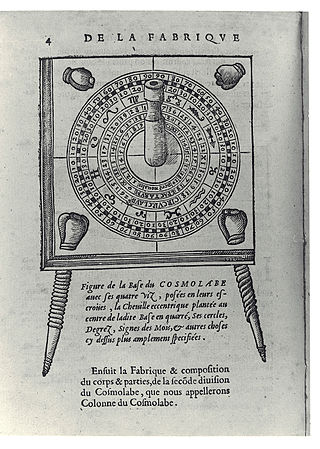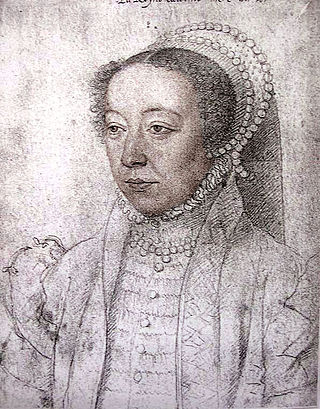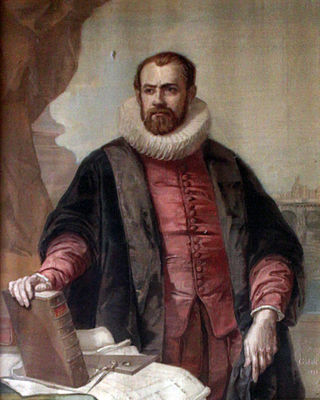Related Research Articles

Pierre Lescot was a French architect active during the French Renaissance. His most notable works include the Fontaine des Innocents and the Lescot wing of the Louvre in Paris. He played an important role in the introduction of elements of classical architecture into French architecture.

The Château d'Anet is a château near Dreux, in the Eure-et-Loir department in northern France, built by Philibert de l'Orme from 1547 to 1552 for Diane de Poitiers, the mistress of Henry II of France. It was built on the former château at the center of the domains of Diane's deceased husband, Louis de Brézé, seigneur d'Anet, Marshal of Normandy and Master of the Hunt.

Salomon de Brosse was an early 17th-century French architect who moved away from late Mannerism to reassert the French classical style and was a major influence on François Mansart.

The Château de Gaillon is a French Renaissance castle located in Gaillon, Normandy region of France.

Jacques Besson (1540?–1573) was a French Protestant inventor, mathematician, and philosopher, chiefly remembered for his popular treatise on machines Theatrum Instrumentorum (1571–1572), which saw many reprints in different languages.
Events from the year 1510 in art.

The French queen Catherine de' Medici was patron for building projects including the Valois chapel at Saint-Denis, the Tuileries Palace, and the Hôtel de la Reine in Paris, and extensions to the château of Chenonceau, near Blois. Born in 1519 in Florence, Catherine de' Medici was a daughter of both the Italian and the French Renaissance. She grew up in Florence and Rome under the wing of the Medici popes, Leo X and Clement VII. In 1533, at the age of fourteen, she left Italy and married Henry, the second son of King Francis I of France. On doing so, she entered the greatest Renaissance court in northern Europe.

Charleval is a commune in the Eure department in northern France.
Events from the year 1584 in art.

The Henry II style was the chief artistic movement of the sixteenth century in France, part of Northern Mannerism. It came immediately after the High Renaissance and was largely the product of Italian influences. Francis I and his daughter-in-law, Catherine de' Medici, had imported to France a number of Italian artists from Raphael's workshop or former assistants of Michelangelo, known as the School of Fontainebleau, where many were based. Frenchmen were trained in the Mannerist idiom. Besides the work of Italians in France, many Frenchman picked up Italianisms while studying art in Italy during the middle of the century. The Henry II style, though named after Henry II of France, in fact lasted from about 1530 until 1590 under five French monarchs, their queens, and their mistresses.

Jacques I Androuet du Cerceau, also given as Du Cerceau, DuCerceau, or Ducerceau (1510–1584) was a well-known French designer of architecture, ornament, furniture, metalwork and other decorative designs during the 16th century, and the founder of the Androuet du Cerceau family. He introduced Renaissance architecture to France with the assistance of Pierre Lescot, Philibert Delorme and Jean Bullant. Though he was referred to by contemporaries as architecte and was even appointed architecte du roi, he is remembered especially for his suites of engravings produced from 1549 from his printshop in Orléans.
Jean Baptiste Androuet du Cerceau (1544/47–1590) was a French architect who designed the Pont Neuf (1579), spanning the Seine, Paris, and became supervisor of the royal works under Henri III and Henri IV, including the Louvre. Several hôtels particuliers are ascribed to him. The Hôtel d'Angoulême, the Hôtel de Lamoignon (1584), which houses the Historical Library of the City of Paris, and the Hôtel de Mayenne. The Hôtel de Mayenne, with rhythmically varied dormer windows set in a high slate roof, has the pediments of its piano nobile windows superposed on the frieze above.

Jacques Androuet du Cerceau, the younger, was a French architect.
Jean Androuet du Cerceau (c.1585–1650) was a French architect, the son of Jean Baptiste Androuet du Cerceau, the outstanding Parisian architect of his generation.
Paul Androuet du Cerceau (1623–1710), was a French goldsmith and engraver, who was active in Paris around 1610. According to Benezit, Reynaud presumes he is the son of the architect Jean Baptiste Androuet du Cerceau, who built the Pont Neuf in Paris, but Paul is now believed to be the grandson of Jacques II Androuet du Cerceau.

The Fountain of Diana, also known as the Diana of Anet and Diana with a Stag, is a marble Mannerist sculpture of the goddess Diana, representing Diane de Poitiers. It was created c. 1550 to be the central ornament of a grand fountain in a courtyard of Diane de Poitier's Château d'Anet, but today is in the Louvre, Room 214 on the ground floor of the Richelieu Wing ; the Louvre has retitled it Diane appuyée sur un cerf. It was long believed to be the work of Jean Goujon, but the identity of the sculptor is now considered uncertain, although Benvenuto Cellini, Germain Pilon, Pierre Bontemps, and Ponce Jacquiot have in turn been suggested.

The Hôtel de Nevers, later the Hôtel de Guénégaud, then the Hôtel de Conti, was a French aristocratic townhouse, which was located on the Quai de Nevers, just east of the former Tour de Nesle on the site of the present day Hôtel des Monnaies in the 6th arrondissement of Paris. Construction began in 1580 to the designs of an unknown architect for Louis Gonzaga, Duke of Nevers, although it was never completed as intended. The large north pavilion on the River Seine was a prominent landmark of its part of the Left Bank. The hôtel was demolished sometime between 1768 and 1771.
References
- Baldus, Eduoard (n. d. [c. 1880]). Oeuvre de Jacques Androuet dit du Cerceau. Meubles. Paris; Edouard Baldus.
- Miller, Naomi (1996). "Du Cerceau. French family of artists.", vol. 9, pp. 350–354, in The Dictionary of Art, edited by Jane Turner, reprinted with minor corrections in 1998. New York: Grove. ISBN 9781884446009.